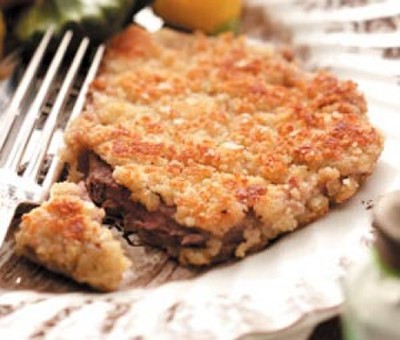
Some of the best meals you’ll ever have are home cooked and made from animals that you were fortunate enough to bring home yourself. With an animal that lived out its entire life in the wild, there’s no worries of artificial growth hormones or poor quality meat due to the animal being fed GMO food and kept penned up in its own filth, never seeing the light of day. That freedom and living life as nature intended results in high quality meat, naturally lean, heart healthy, and full of flavor.
Previously, we took a look at some basic cooking tips for venison and gave you some suggestions on ways to cook your deer that are both simple and delicious. To further inspire your creativity and willingness to cook and enjoy eating the deer you bring home, here is a recipe for breaded venison steaks. It’s a simple recipe that goes well with any vegetable combination. It’s also filling and kid-friendly.
You won’t need any unusual ingredients for this recipe, and it takes just under an hour from start to finish. It also cooks beautifully in a cast iron skillet. Best of all, you can use this same recipe with any type of venison steak. I’ve made it using butterfly chops and even odd sized pieces of meat I salvaged off half a deer a family member didn’t want to bother cutting up. Thickness of the meat doesn’t alter the recipe or the taste much, but it thicker pieces of meat will require longer cooking time.
Helpful Tip: If you need to thaw your steaks out, do so in hot water and not in a microwave. Microwaving meat breaks down the cell walls, causing tasty juices and important nutrients to run out. This leads to tougher meat with less flavor and nutrition that cannot be recovered. Thawing out frozen meat in hot water ensures that cell walls stay intact, maintaining nutritional content, moisture, and flavor.
Recipe for Breaded Venison Steaks
Ingredients
Getting Started
In a bowl large enough to accommodate the largest steak, crush the corn flakes with a potato masher. They don’t need to be powdered, but they do need to be in small enough pieces so that they will actually stick to the meat. Once down to a good consistency, add your seasonings and stir the mixture up a little to blend the seasonings evenly throughout.
In another bowl of similar size, crack and scramble two eggs.
Set your stove to medium-low and get your pan heated up. Add the lard, butter, or olive oil right away.
One at a time, place a steak into the dish with the eggs in it. Flip the steak around to ensure that is thoroughly coated in egg. Then set it into the dish with your corn flake breading mixture. Throw a handful of the breading mixture on top of the steak and press into the steak. Flip the steak over and place more of the breading on this side, pressing it into the steak. Once it’s thoroughly coated, place the steak in your skillet and let it start cooking. Repeat with the rest of your steaks.
Cooking the Steaks
As this is a bit of a process, it’s best to start with the largest steaks first. Being larger, they’ll need more time to cook and this helps ensure that all the steaks are finished cooking at the same time. Throughout cooking, you’ll want to keep the heat at about medium-low. Too hot of a pan will cause the breading to burn and will mean that the steaks cook unevenly, with the outsides perfect and the inside still raw and inedible.
Cook the steaks on one side until the bottom starts to turn dark brown, then flip it over and cook the other side. Depending upon the thickness of your steaks, this could take anywhere from 15 to 30 minutes per side. It’s important not to rush the steaks as the breading will just burn and the steak will become tough. You may need to add more butter, olive oil, or lard when you flip the steak over to ensure it cooks evenly, doesn’t burn to the pan, and stays moist and tender.
Helpful Tip: Venison differs from other meat in that it needs to be cooked in order to enjoy eating. Medium rare doesn’t work with venison as that uncooked center meat will be tough and near impossible to chew. Cooking steaks until they are medium well at the very least will ensure that the meat is soft and tender –as properly cooked venison should be.
Once the other side of the steak starts to turn dark brown in places, it’s best to check the inside of the meat to make sure it’s done. The breading can give the appearance that the steaks are done sooner than they actually are. The meat inside should be dark with no pink juices running. If the inside is dark and evenly colored with no running fluid, your steak is good to go.
Recipe for Breaded Venison Steaks Conclusion
And that’s all there is to it! This is a really simple recipe that’s easy to put together with ingredients you already have in your kitchen. You can pair it with a wide range of side dishes and even picky eaters will find it difficult to resist the smell and taste of these breaded venison steaks.